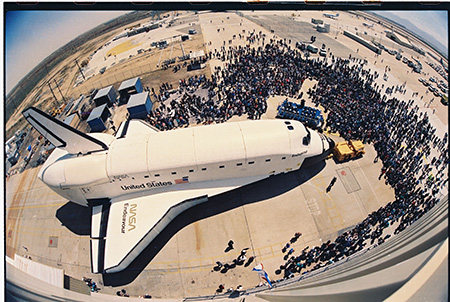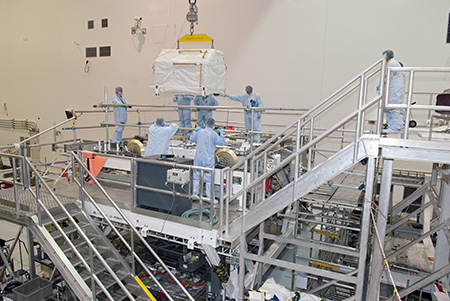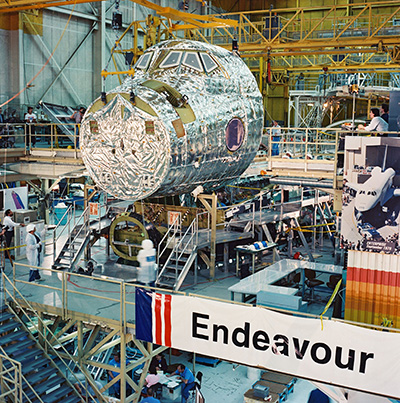Boeing Supports Space Shuttle Endeavour's Final Flight
 KENNEDY SPACE CENTER, Fla., April 28, 2011 -- Boeing [NYSE: BA] engineers and technicians are supporting Space Shuttle Endeavour's final mission by helping to prepare the orbiter for its April 29 launch and leading the processing of the payload. Mission STS-134 will carry the Alpha Magnetic Spectrometer-02 (AMS-02) and a large external platform called the Express Logistics Carrier 3 (ELC-3) to the International Space Station.
KENNEDY SPACE CENTER, Fla., April 28, 2011 -- Boeing [NYSE: BA] engineers and technicians are supporting Space Shuttle Endeavour's final mission by helping to prepare the orbiter for its April 29 launch and leading the processing of the payload. Mission STS-134 will carry the Alpha Magnetic Spectrometer-02 (AMS-02) and a large external platform called the Express Logistics Carrier 3 (ELC-3) to the International Space Station. "The AMS is a hosted payload for which we provide the facility, infrastructure, ground support and procedures, and orchestrate all the testing for the ISS and the interface with the space shuttle," said Bob Hart, Boeing STS-134 Payload Flow manager. "Boeing also helped ensure that the AMS and ELC could be installed on the station’s truss structure."
Boeing is responsible for the coordination, planning, buildup, testing and checkout of the hardware installed on the ELC-3. ELC-3 arrived at Kennedy Space Center in December 2009 as a bare carrier. Boeing integrated spare parts onto the carrier from several companies and NASA centers.
Another Boeing contribution to this mission is the 0.5-inch protrusion installed on a special test tile under Endeavour's left wing. This protrusion, designed by Boeing engineers, will trip a boundary layer that flows around the orbiter as it re-enters the atmosphere in the Mach 19-20 range. The tile protrusion causes turbulent airflow that will be measured by several sensors on and downstream of the protrusion. During this fifth and final tile test, Boeing and NASA engineers will gather data that will help design better heat shields for future spacecraft.
The STS-134 crew will transfer Endeavour’s 50-foot boom, used for inspecting the orbiter’s heat shield, to the ISS for indefinite storage on Boeing-provided hardware located on the Starboard 1 truss segment. The boom can be used with the station’s robotic arm to extend its reach to the solar arrays or other areas where repairs may be required.
Endeavour rolled out of Boeing's Palmdale, Calif., plant on April 25, 1991, and has flown 25 missions, traveled 108 million miles and spent 295 days in space. It was the fifth space shuttle to be built, constructed as a replacement for Challenger, which was lost in 1986. Endeavour was largely constructed from structural spare parts and was built in considerably less time than previous orbiters.
Endeavour flew the first assembly mission to the ISS, STS-88 in 1998. STS-134 marks the final ISS assembly mission.
Boeing is a major subcontractor to United Space Alliance (USA), NASA's prime contractor for space shuttle operations. Under this contract, Boeing provides NASA and USA with sustaining engineering, engineering support to operations -- including launch -- and overall shuttle systems and payload integration services. Boeing is the designer and manufacturer of the space shuttle orbiters.
Boeing is NASA's prime contractor for the ISS. In addition to designing and building the major U.S. elements, Boeing also is responsible for ensuring the successful integration of new hardware and software -- including components from international partners -- as well as for providing sustaining engineering work.
The @BoeingDefense Twitter feed (www.twitter.com/boeingdefense) will participate in NASA's STS-134 Tweetup from Kennedy Space Center on April 28-29.
A unit of The Boeing Company, Boeing Defense, Space & Security is one of the world's largest defense, space and security businesses specializing in innovative and capabilities-driven customer solutions, and the world's largest and most versatile manufacturer of military aircraft. Headquartered in St. Louis, Boeing Defense, Space & Security is a $32 billion business with 66,000 employees worldwide. Follow us on Twitter: @BoeingDefense.
Source: BOEING


















